Understanding the Working Principle and Common Issues of Diaphragm Carburetors
Introduction
Diaphragm carburetors are essential components in various machines, serving a crucial role in fuel delivery and combustion processes. In this blog post, we will explore the structure, functionality, and working principles of diaphragm carburetors, shedding light on their common applications and potential issues.
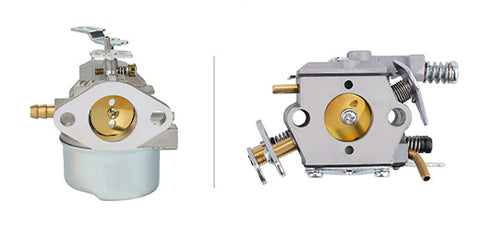
Structure and Applications
Diaphragm carburetors, known for their versatility and efficiency, consist of key components such as the intake port, negative pressure port, and fuel inlet. These carburetors find widespread use in small engines, motorcycles, chainsaws, and other machines requiring precise fuel-air mixture control. The intricate design of these carburetors ensures optimal performance in diverse operating conditions.

Intake Port: This is where air enters the carburetor.
Negative Pressure Port: Connected to the piston, it plays a crucial role in creating the necessary vacuum for fuel delivery. The negative pressure port is as below.

Fuel Inlet: This is the entry point for fuel into the carburetor. Picture below.
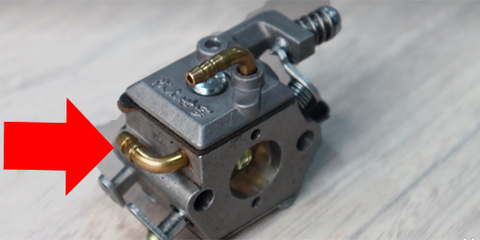
Functionality and Working Principles:
Diaphragm carburetors integrate the functions of both a fuel pump and a carburetor, simplifying the fuel delivery process. Understanding their working principles involves examining the diaphragm's behavior as the piston moves through different positions.
Upward Movement of Piston: As the piston moves upward, the negative pressure tube generates pressure, transferring it to the diaphragm. This upward motion creates a sealed area within the diaphragm, inducing a vacuum at the fuel inlet. Through a unidirectional valve, fuel is drawn into the recessed area covered by the diaphragm.
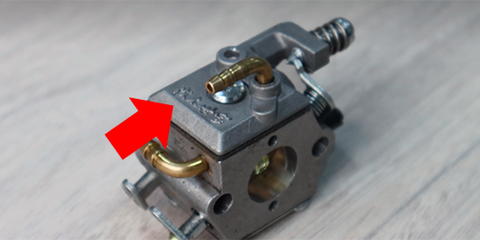
Downward Movement of Piston: When the piston moves downward, positive pressure is transmitted through the negative pressure tube, causing the diaphragm to move downward. This action compresses the previously drawn fuel, pushing it into the carburetor's metering chamber for precise fuel measurement.

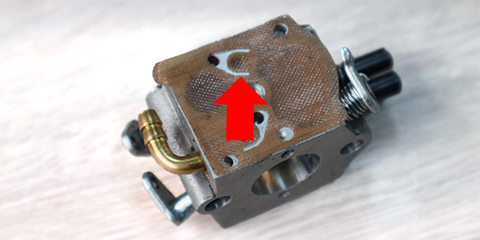
one-way valve on diaphragm carburetor
Metering and Combustion:
The metering chamber, equipped with a diaphragm featuring a metal protrusion, plays a crucial role in regulating fuel flow. As the piston moves upward, the diaphragm lifts the metal protrusion or presses down on a metal needle, allowing gasoline from the upper chamber to flow through holes. The mixture then passes through the idle screw (L screw) and high-speed screw (H screw), reaching the combustion chamber after atomization.
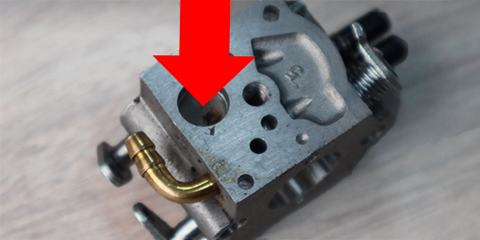
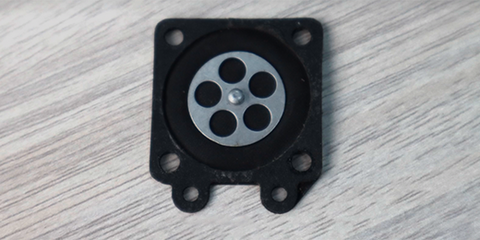
metal protrusion
Diaphragm carburetors, with their ingenious design and dual functionality, contribute significantly to the efficiency of various machines. By comprehending their structure and working principles, users can better appreciate the importance of these components. However, like any mechanical system, diaphragm carburetors are susceptible to issues such as clogging or wear over time, emphasizing the need for regular maintenance to ensure optimal performance.
Common Problems and Troubleshooting of Diaphragm Carburetors:
Stiff Diaphragm:
Symptoms: Difficulty in starting the engine, poor acceleration, or irregular idling.
Troubleshooting: Check for dirt, debris, or varnish accumulation on the diaphragm. Clean the diaphragm and surrounding components, ensuring smooth movement. If the diaphragm is damaged or worn, replace it with a new one.
You could find the new diaphragm for your carburetor here
Blocked Holes:
Symptoms: Engine stalling, uneven performance, or loss of power.
Troubleshooting: Inspect the carburetor for clogged or obstructed fuel and air passages. Clean the carburetor thoroughly, paying special attention to tiny holes and channels. Use carburetor cleaner and compressed air to remove any debris. Regularly clean and maintain the carburetor to prevent future blockages.
Damaged Non-Return Valve:
Symptoms: Fuel leakage, poor fuel delivery, or flooding.
Troubleshooting: Examine the non-return valve for wear, tears, or damage. If faulty, replace the valve with a new one. Ensure that the valve is seated correctly and functions properly to prevent fuel from flowing back into the carburetor when it should be closed.
Idle Issues - Incorrect Mixture:
Symptoms: Rough idling, stalling at low speeds, or difficulty maintaining a stable idle.
Troubleshooting: Adjust the idle mixture screws (L screw) and (H screw) to achieve the correct air-fuel mixture. If the idle remains unstable, clean the carburetor, paying attention to the idle circuit. Check for vacuum leaks, gaskets, or seals that may be compromised, affecting the mixture.
Fuel Starvation or Flooding:
Symptoms: Engine runs lean (starvation) or rich (flooding), resulting in poor performance.
Troubleshooting: Inspect the fuel inlet and needle valve for proper functioning. Adjust the float level if necessary to regulate fuel supply. Ensure that the fuel pump, if present, is delivering fuel consistently. If flooding persists, check for a stuck needle valve and correct the issue.
Irregular Combustion:
Symptoms: Backfiring, misfires, or erratic engine behavior.
Troubleshooting: Verify that the diaphragm and associated components are in good condition. Check for air leaks around the carburetor and intake manifold. Adjust the high-speed screw (H screw) for optimal fuel mixture at higher RPMs. If issues persist, consult the manufacturer's guidelines for further diagnostics.
Regular maintenance, inspection, and prompt troubleshooting can help address these common issues with diaphragm carburetors, ensuring reliable performance and extending the lifespan of the engine.












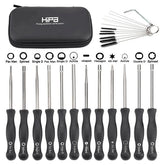
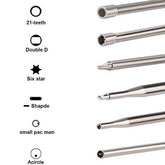
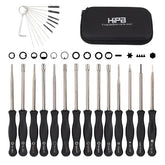
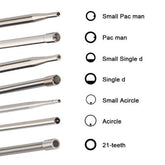





6 Comments
vibration analysis
Vibration analysis is a crucial technique employed in various industries to monitor and maintain the health of rotating machinery. One of the standout devices in the realm of vibration analysis is the Balanset-1A, a portable balancer and vibration analyzer designed for dynamic balancing of a wide array of rotor types, including crushers, fans, mulchers, augers on combines, shafts, centrifuges, and turbines. This advanced device is essential for ensuring optimal machine performance and longevity, making it a vital component in manufacturing and maintenance sectors.
The Balanset-1A is equipped with dual channels, which enhances its capability to conduct vibration analysis in two planes. This feature allows it to assess the vibration status of rotors comprehensively. The versatility of the Balanset-1A makes it suitable for numerous applications across various industries, ensuring that different mechanical systems can be effectively monitored and balanced.
One of the primary functions of the Balanset-1A is its ability to monitor rotational speed, phase angle, and the fundamental frequency of vibration. By utilizing advanced components such as vibration sensors and an optical laser tachometer, this device provides accurate measurements essential for vibration analysis. The Broad spectrum analysis capabilities offered by the Balanset-1A include FFT spectrum analysis, overall vibration monitoring, and a measurement logging feature that archives data for further evaluation.
In terms of functionality, the Vibration analysis features of the Balanset-1A can be split into two main operational modes: Vibrometer mode and Balancing mode. In Vibrometer mode, the device competently measures critical parameters such as rotational speed (RPM) and analyzes the fundamental frequency component of vibration. It also provides a detailed frequency spectrum analysis and overall vibration levels, allowing operators to track any variations indicating potential problems.
In Balancing mode, the Balanset-1A efficiently executes single-plane and two-plane balancing. This balancing capability is crucial for reducing vibrations within mechanical systems. It utilizes advanced features like a polar graph for accurately placing weights to visualize imbalances and a tolerance calculator that aligns with ISO 1940 standards for acceptable balancing tolerances.
The Balanset-1A also comes with additional functionalities that enhance its usability and ensure precise vibration analysis and balancing. It features a restore last session option, enabling users to quickly resume previous balancing sessions. The graphical representation of data through overall charts, harmonic charts, and spectrum charts provides visual insights into the vibration patterns and the associated frequency spectrum. These charts play a pivotal role in diagnosing issues and understanding the condition of machinery.
Moreover, the Balanset-1A supports both Imperial and Metric measurement systems, catering to a wide range of users globally. This feature ensures that it can be used effectively in different regions, promoting its appeal across various industrial sectors.
The specifications of the Balanset-1A further illustrate its robust capabilities. It comes equipped with two vibration sensors, an optical laser tachometer, and a USB interface allowing for seamless software connectivity. The comprehensive measurement ranges, accurate at В±(0.1 + 0.1*Vi), and the well-defined limits of permissible errors portray the reliability of this vibration analysis tool. Furthermore, it is lightweight, weighing only 4 kg, making it portable for on-site assessments.
One of the significant advantages of using vibration analysis is its role in predictive maintenance. By regularly conducting vibration analysis, organizations can identify potential failures before they occur, leading to reduced downtime and lower maintenance costs. The Balanset-1A facilitates this by allowing for the archiving and retrieval of past measurement data, enabling trends to be analyzed over time. This trend analysis is instrumental in anticipating maintenance needs, ultimately leading to more efficient operational practices.
The Balanset-1A is user-friendly, equipped with intuitive software that measures vibration, phase angle, and calculates necessary correction mass values. This aspect simplifies the balancing process, allowing even those with limited technical knowledge to effectively utilize the device.
In summary, vibration analysis is indispensable for ensuring the smooth operation of rotating machinery. The Balanset-1A stands out as an exceptional tool for achieving accurate dynamic balancing and comprehensive vibration analysis. Its portability, advanced features, and user-friendly interface make it an ideal choice for industries focused on maintaining the integrity and efficiency of their mechanical systems. With the Balanset-1A, organizations can not only improve their machinery’s performance but also extend its lifespan and reduce the likelihood of unexpected breakdowns, emphasizing the critical importance of vibration analysis in today’s industrial landscape.